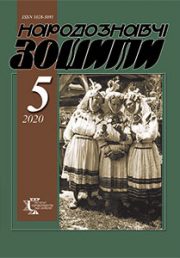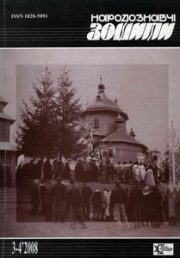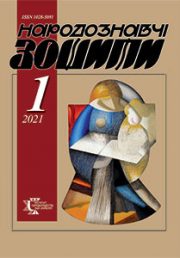The Ethnology Notebooks. 2022. № 3 (165), 691—705
UDK [94:353.8](477.83-22Селисько)”1939/1947″:930.2
DOI https://doi.org/10.15407/nz2022.03.691
HORBAL Маrіa
- ORCID ID: https://orcid.org/0000-0001-9287-8336
- leading scientific editor,
- The Institute of Ethnology of the National
- Academy of Sciences of Ukraine,
- 15, Svobody Avenue, 79000, Lviv, Ukraine,
- Contacts: e-mail:horbal.m@gmail.com
Abstract. The purpose of the article is to shed light on the life of the village during the Soviet and German occupation in 1939—1947 through the prism of the memories of the residents of the village of Selysko, Lviv Region, now Pustomytivsky District (geographical boundaries of the study), with the involvement of historical sources and archival materials (chronological boundaries of the study).
The relevance of the topic is due to the return from oblivion, the reproduction of the historical events of this area that go into the past. These include the occupation of the village by the Red Army on September 22, 1939, the deportation of villagers of other nationalities (Poles, Germans, Jews), the period of collectivization and taxes from the peasants, the famine in the fall of 1941 — the spring of 1942, the occupation of the village by German troops in mid-July 1941 year (the peasants were taken to Germany for forced labor) the occupation of the village for the second time by Russian-Bolshevik troops, the famine of 1947. These questions are the subject of research.
Much attention is paid to the moral and psychological state of the peasantry, its leaders, whose demoralization was influenced by the occupation regimes. After all, with the arrival of Soviet-Bolshevik power, repressions begin. Symbols sacred to Galicians were banned: the blue-yellow flag and trident, the anthem. That is, the implementation of Soviet policy related to the Sovietization of the region, staffing, ideological component and activities of the NKVD members began.
The life history of this village of the outlined period is mirrored by the life of villagers throughout Western Ukraine.
The research methodology is based on the application of the principles of scientificity, objectivity and historicism, and in the process of studying the material, the method of historical reconstruction and field ethnographic research was used, in particular interviewing and photographing respondents.
Keywords: Selsko village, Lviv region, 1939, collectivization, famine of 1941—1942, German-fascist occupation, Bolshevik occupation, famine of 1947.
Received 21.07.2022
REFERENCES
- Dudykevich, R. (Without raw data). Memories [in Ukrainian].
- Baran, V.K. (2009). Ukraine: Western lands: 1939—1941. Lviv [in Ukrainian].
- Schematism for the year 1924. (1924). Lviv: Order of the High Clergy [in Ukrainian].
- A village in the western regions of Ukraine: social transformations (September 1939 — June 1941). Retrieved from: https://mydisser.com/ru/avtoref/view/12981.html (Last accessed: 15.07.2022) [in Ukrainian].
- DALO. F. R-285. Op. 1. Ref. 11. Ark. 24 [in Ukrainian].
- Melnyk, Nadia. (2022). Gabrusevichi Priestly family. Lviv [in Ukrainian].
- Hauchman, Mykhailo, Lviv pogrom. (This day in history). Retrieved from: https://www.jnsm.com.ua/h/0630T/ (Last accessed: 15.07.2022) [in Ukrainian].
- Lukyaniuk, Volodymyr. Act of Proclamation of the Ukrainian State. (This day in history). Retrieved from: https://www.jnsm.com.ua/h/0630N/ (Last accessed: 15.07.2022) [in Ukrainian].
- DALO. F. R-35. Op. 2. Spr. 170. Ark. 1 [in Ukrainian].
- Lutsky, Oleksandr. Social assistance to the residents of Prykarpattia (autumn 1941 — summer 1942). Retrieved from: http://history.org.ua/JournALL/xxx/xxx_2011_16/22.pdf (Last accessed: 15.07.2022) [in Ukrainian].
- Holodomor in Ukraine (1946—1947). Retrieved from: https://uk.wikipedia.org/wiki/%D0%93%D0%BE%D0%BB%D0%BE%D0%B4%D0%BE%D0%BC%D0%BE%D1%80_ %D0%B2_%D0%A3%D0%BA%D1%80%D0%B0%D1%97%D0%BD%D1%96_(1946%E2%80%941947) (Last accessed: 15.07.2022) [in Ukrainian].







